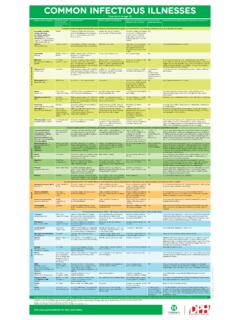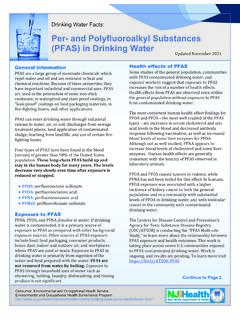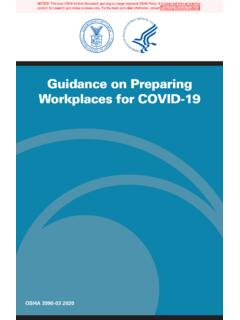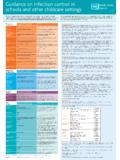Transcription of Laboratory Biosafety and Biosecurity Risk Assessment …
1 Laboratory Biosafety and Biosecurity Risk Assessment Technical Guidance Document International Biological Threat Reduction, Sandia National Laboratories, in collaboration with The International Federation of Biosafety Associations 1. This work was funded by the US Department of State Biosecurity Engagement Program. 2. Table of Contents 5. DEFINITIONS .. 6. SCOPE AND INTENDED AUDIENCE .. 9. I. INTRODUCTION TO Laboratory RISK Assessment .. 10. Importance and Benefits .. 10. Risk Communication, Risk Acceptance, and Perceived Risk .. 11. When to Perform and Review a Laboratory Risk Assessment .. 12. Roles and Responsibilities for Risk Assessment .. 13. II. Laboratory Biosafety AND Biosecurity DEFINITIONS .. 16. Complementary Roles of Biosafety and Biosecurity in Biorisk 16. Laboratory risks .
2 18. Biosafety 19. Biosecurity risks .. 19. III. Laboratory RISK Assessment METHODOLOGY .. 21. 1. Define the situation .. 23. 2. Define the risks .. 24. 3. Characterize the risks .. 25. 4. Determine if the risks are acceptable .. 28. 5. Implement risk mitigation measures, as needed .. 29. Biosafety Risk Assessment Process Summary .. 30. Biosecurity Risk Assessment .. 31. 1. Define the situation .. 32. 2. Define the risks .. 33. 3. Characterize the risks .. 34. 4. Determine if the risks are acceptable .. 38. 5. Implement risk mitigation measures, as needed .. 38. Biosecurity Risk Assessment Process Summary .. 40. IV. SCENARIO AND EXERCISES .. 41. Exercise A. Biosafety Risk Assessment .. 42. Exercise B. Biosecurity Risk Assessment .. 47. ADDITIONAL REFERENCES .. 51. 3. 4. ABBREVIATIONS.
3 CWA CEN Workshop Agreement IBC Institutional Biosafety committee IRGC International Risk Governance Council ISO International Organization for Standardization LAI Laboratory -acquired infection GMO Genetically-modified organisms OHSAS Occupation Health and Safety Assessment Series VBM Valuable biological materials VLM Valuable Laboratory materials WHO World Health Organization 5. DEFINITIONS. Adversary Individual with malicious intent. Asset An item of value. Biohazard The potential source of harm caused by biological agents or toxins (Source: CWA 15793). Biorisk A combination of the probability of occurrence of harm and the severity of that harm where the source of harm is a biological agent or toxin (Source: CWA 15793). The source of harm may be an unintentional exposure, accidental release or loss, theft, misuse, diversion, unauthorized access or intentional unauthorized release.
4 Biorisks include both Biosafety and Biosecurity risks . Biorisk Assessment A process of evaluating the biorisk(s) arising from a biohazard(s), taking into account the adequacy of any existing controls, and deciding whether or not the biorisk(s) is acceptable (Source: CWA 15793). Biological facility A building or place that includes one or more biological laboratories. Biological Laboratory A room within a facility, designated for work on biological agents and/or toxins (Source: CWA. 15793). Biorisk management The analysis of ways and development of strategies to minimize the likelihood of the occurrence of biorisks. The management of biorisk places responsibility on the facility and its manager to demonstrate that appropriate and valid biorisk reduction (minimization) procedures have been established and are implemented.
5 A biorisk management committee should be established to assist the facility director in identifying, developing, and researching biorisk management goals ( Laboratory Biosecurity Guidance, 2006). Biorisk management advisor An individual who has expertise in the biohazards encountered in the organization and is competent to advise top management and staff on biorisk management issues (Source: CWA. 15793). Depending on national guidelines and institutional traditions, the role of a biorisk management advisor may be differently named ( Biosafety officer, Biosecurity officer, biorisk manager, or biorisk management officer). 6. Biorisk management system Part of an organization's management system used to develop and implement its biorisk policy and manage its biorisks (Source: CWA 15793).
6 A management system is a set of interrelated elements used to establish policy and objectives and to achieve those objectives. A management system includes organizational structure, planning activities (including, for example, risk Assessment and the setting of objectives), responsibilities, practices, procedures, processes, and resources. Biorisk mitigation Actions and control measures that are put into place to reduce or eliminate the risks associated with biological agents and toxins and other Valuable Laboratory Material (VLM). Biosafety risk Assessment An analytical procedure designed to characterize safety risks in a Laboratory . A Biosafety risk Assessment allows a Laboratory to determine the relative level of risks its different activities pose and helps guide risk mitigation decisions so they are targeted to the most important risk.
7 A. Biosafety risk Assessment should consider every activity and procedure in a Laboratory that involves infectious disease agents. Biosecurity risk Assessment An analytical procedure designed to characterize security risks in a Laboratory . A Biosecurity risk Assessment should consider every asset as well as every vulnerability in an institution and its component laboratories and units. Community People outside the workplace potentially affected by the activities of the facility (Source: CWA. 15793). Harm The adverse effect on the health of people, animals, or plants on the environment or on property (Source: CWA 15793). Hazard A source, situation, or act with a potential for causing harm (Source: CWA 15793). Incident An event with a potential for causing harm (Source: CWA 15793).
8 Insider Individual with authorized access. Laboratory Biosafety The set of containment principles, technologies and practices that are implemented to prevent the unintentional exposure to biological agents and toxins, or their accidental release. 7. Laboratory Biosecurity The set of measures aimed at the protection, control and accountability for valuable biological materials (VBM, see definition below) and protection of other valuable items ( equipment). within laboratories, in order to prevent their loss, theft, misuse, diversion of, and/or unauthorized access or intentional unauthorized release. Outsider Individual without authorized access. Risk A combination of the probability of occurrence of harm and the severity of that harm (Source: CWA 15793). Risk Assessment A process of evaluating the risk(s) arising from a hazard(s), taking into account the adequacy of any existing controls and deciding whether or not the risk(s) is acceptable (Source: CWA.)
9 15793). Threat The likelihood for an adverse event to occur, as an expression of intention to inflict evil, injury, disruption or damage ( Laboratory Biosecurity Guidance, 2006). Valuable Biological Material Biological materials that require (according to their owners, users, custodians, caretakers or regulators) administrative oversight, control, accountability, and specific protective and monitoring measures in laboratories to protect their economic and historical (archival) value, and/or the population from their potential to cause harm. VBM may include pathogens and toxins, as well as non-pathogenic organisms, vaccine strains, foods, genetically-modified organisms (GMOs), cell components, genetic elements, and extraterrestrial samples ( Laboratory Biosecurity Guidance, 2006).
10 Valuable Laboratory Material Material of value to the Laboratory due to its replacement cost and its necessity for the Laboratory operational purposes. An example of VLM is Laboratory equipment. Such material may be of interest to individuals outside the Laboratory for other purposes ( monetary or resource value, illegal drug production, etc.). 8. SCOPE AND INTENDED AUDIENCE. The scope of this document is to provide technical guidance to all personnel who work in a biological Laboratory and who actively handle or manage biological agents and toxins, as well as other valuable Laboratory material. This document is also intended for facility managers, administrative support, security forces, community stakeholders, oversight bodies, and policy- makers, who want to learn more about risk Assessment and the safety and security risks that are present in their laboratories.
















